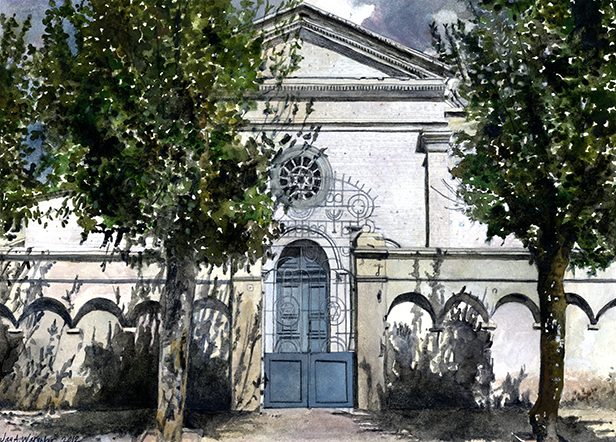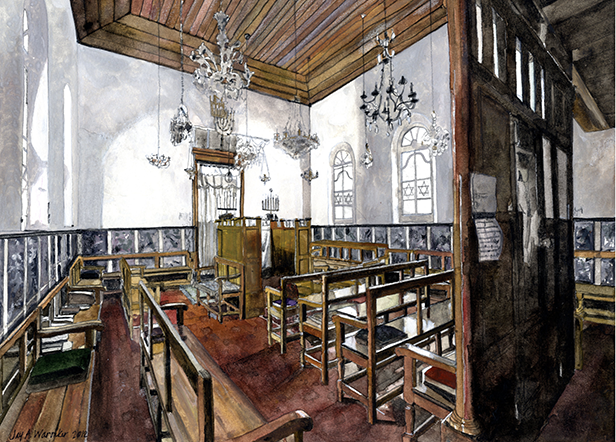 Exterior View (2012), 15” x 11” Watercolor, Jay A. Waronker
Exterior View (2012), 15” x 11” Watercolor, Jay A. Waronker
Eritrea
Asmara Synagogue (Completed in 1906) |
|

Interior View (2012), 15” x 11” Watercolor, Jay A. Waronker
|
In the nineteenth and early twentieth centuries, the seaport city of Aden in Yemen as a British colony was home to a substantial number of Jews. By the 1920s and early 1930s, the socio-political situation of Jewish community among the wider population had deteriorated, and some Jews choose to leave at that time. This pattern continued in the 1940s, 50s, and early 60s, with more Jews emigrating, including several to Israel. In 1967, the British finally surrendered Aden, and nearly all of the remaining Adenite Jews left with them, moving mostly to Israel or Great Britain. A small contingency wanted to remain in the region, however, and they came to settle across the Red Sea or Gulf of Aden in Djibouti, Ethiopia, and Eritrea.
By the early years of the twentieth century, Asmara in central Eritrea had a large and sustainable enough Jewish community to build a small neo-classical synagogue. The community, which peaked according to some accounts at five-hundred people after World War II, was made up mostly of Jews from Aden, yet there were others. As a product of Italian colonialism, Asmara also included a handful of Italian Jews and well those from an assortment of countries as refugees of Nazi Europe. For some years, prayer services and community activities had taken place in private homes or temporary facilities, but eventually a proper synagogue to serve as a center for Jewish religious and social life was needed. A sanctuary with support spaces was built just off the main street, Harnet Avenue, on a parcel of land at the corner of Senafe and Seraye Streets near the Impera Cinema in central Asmara.
The building, begun in 1905 and completed in 1906, is a quintessential classical temple form, symmetrical in design, with a pediment, blank entablature, and pilasters at the corners of the face. Considering that Asmara was under Italian rule at that time and the much of the city’s planning and architecture was distinctly Italian, such a building no doubt seemed suitable to the times. The entry doors to the synagogue, a paneled-wood pair painted slate blue with a half-round transom above, are along the short side, and they are flanked by a pair of matching wall niches. The niches and doors are linked by an arched band of trim along their tops. In the body of the façade above the doors is a round window with a Star of David pattern set in stained glass. The building’s facade is not finished in masonry or plaster, but in small smooth gray, black, and white ceramic tiles. The central temple-like mass is flanked by smaller matching side wings each with shed roofs.
Original to the synagogue is a masonry and plaster wall painted gray along the street with a decorative painted wrought iron gate centered on the building. The gate is decorated with menorot (candelabras) and Stars of David. A small strip of space exists between this wall and the building, and placed here are two freestanding columns defining the path to the synagogue’s entry. These seem to recall the Boaz and Jachin columns that are believed to have been positioned in front of the ancient Temple in Jerusalem.
The synagogue is made up of a very small entry vestibule within a double-height sanctuary space. The room features white plaster walls with a marble wainscot, a gallery level for women’s seating (as per Orthodox Jewish custom), wood-paneled ceiling, and a centrally-positioned wooden bimah (table where the Torah is read). The attractive and intimate sanctuary is decorated with donation, dedication, and yarhzeit (memorial) plaques, wall-hung Jewish art, and crystal and metal chandeliers hanging from the ceiling. Off to the sides of the sanctuary are small support spaces and a stair up to the gallery.
Next door to the synagogue sanctuary is a small building that once served as a Jewish school house. During the heyday of Jewish life in Asmara, many of its Jews lived and operated businesses in the streets near the synagogue and school.
Eritrea underwent a period of tremendous transition during and after World War II, including British occupation followed by Ethiopian annexation in 1961 that eventually resulted in decades of civil war between the two countries. When the autocratic and intolerant regime of the Derg under the leadership of Mengistu Haile Mariam came into power in Ethiopia in 1974, more Jews including the last rabbi were essentially forced out of Eritrea. These difficult periods led to the substantial decline and eventual demise of Eritrea’s Jewish community. By the late 1970s, only a few dozen of the most hardened and stubborn Jews remained.
By the end of Eritrea’s war with Ethiopia in 1991 and its independence two years later, Asmara had essentially lost its entire long-standing Jewish community. By the early years of the twenty first century, only one Jew, the native-born Samuel Cohen, was left in town. For years Cohen has served as the caretaker of the synagogue and its resident historian. The synagogue, lonely and often closed, continues to be adequately maintained and watched over, yet prayer services are rarely held here since a minyan (quorum for a full service) cannot be organized. The building survives today more as a relic of a bygone era and a curious tourist destination for those that are able to get a tourist visa to the country than as a fully-operational Jewish house of prayer and community center.
On the edge of Asmara, an Italian cemetery dating to the late nineteenth century can be visited, and here there is a Jewish section. Over the years, some 150 members of the Jewish community have been buried here, and the last was in the late 1990s.
